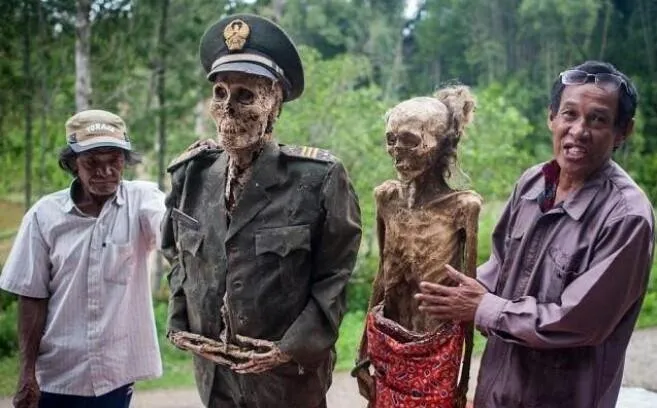Once a year in Toraja, South Sulawesi, the indigenous people there perform a death ceremony called Ma'Nene..
In August, the corpses were taken from their graves to be cleaned, dressed, and changed. after which the corpses will walk alone to where their original grave.
For Toraja people who are in the mountainous region of South Sulawesi, Indonesia, the ritual of the care of the dead has become commonplace.
Once a year, precisely in August, Ma'Nene ritual takes place. during this period many families climbed the cliffs and entered the caves in the nearby countryside, to collect the corpses of their families, to be bathed, kept and changed.
the mummy's body was then paraded from the village in an upright position, and taken back to its resting place.
Interesting, but this process is actually just continuing the old ritual that occurred before Toraja lost their territory due to Dutch colonialism.
in general Torajan people are very isolated people. Their village was built in from one family, which eventually made everyone in the village a family member. although the Toraja people will travel from village to village and family to family, they will not be too far out of the nature where they are.
the reason for this caution is that Torajans believe that when they die, the spirit will linger around the body before it can be guided to the 'Puya', the land where souls are.
In order for this to happen, the body must be with the family for the process to take place. if someone is far outside the area when they die, they may not be found and their spirits will last forever with the body.
Luckily Toraja people have the means to overcome the lost body, although the price is expensive and only for certain people.
this service comes from a 'magician' who can summon the lost body and soul, and make it walk back to the village. Upon hearing his call, the corpse would then rise up and begin his rigid journey without expression to his home.
once the walking corpse is found, people will run forward to warn others that the corpse is headed towards them. This is not out of fear, but another aspect of the ritual, to make sure the corpse will make its way home as soon as possible. if anyone had a direct communication with his body, his body would have collapsed to the ground and died no more. The person with the corpse will tell all that is in his path that this is a walking corpse, and not to make contact.
once the corpse had completed its journey, the body was wrapped and placed in a safe place, usually in a room beneath his house. For the upper classes, the bodies will lie between their Tongkonan poles, the elevated ancestral homes. here the body will wait for the burial party, it can be in a few days or sometimes for months. The party can be very expensive, and the higher the class in the family, the more expensive the party. the party will be attended by thousands of Toraja people, and can last for days, and include chicken fights, carbide and chicken slaughters.
At the end of the party, the body will be washed, prepared and dressed, to be finally taken to his retreat. according to legend, in the past, the corpse will walk towards its resting place. Generally the body will be placed in a coffin placed in a cave on top of the cliff or in the hollow part of the cliff. if the deceased is a child, the coffin will be suspended from the side of the cliff through the rope and vines, which will eventually fall to the ground.
The Toraja people firmly believe that bodies and spirits must be placed between the heavens and the earth, then burials should be at altitude. wooden statues carved as a sign of the dead, and these adorn the cliffs and mouth of the cave.
